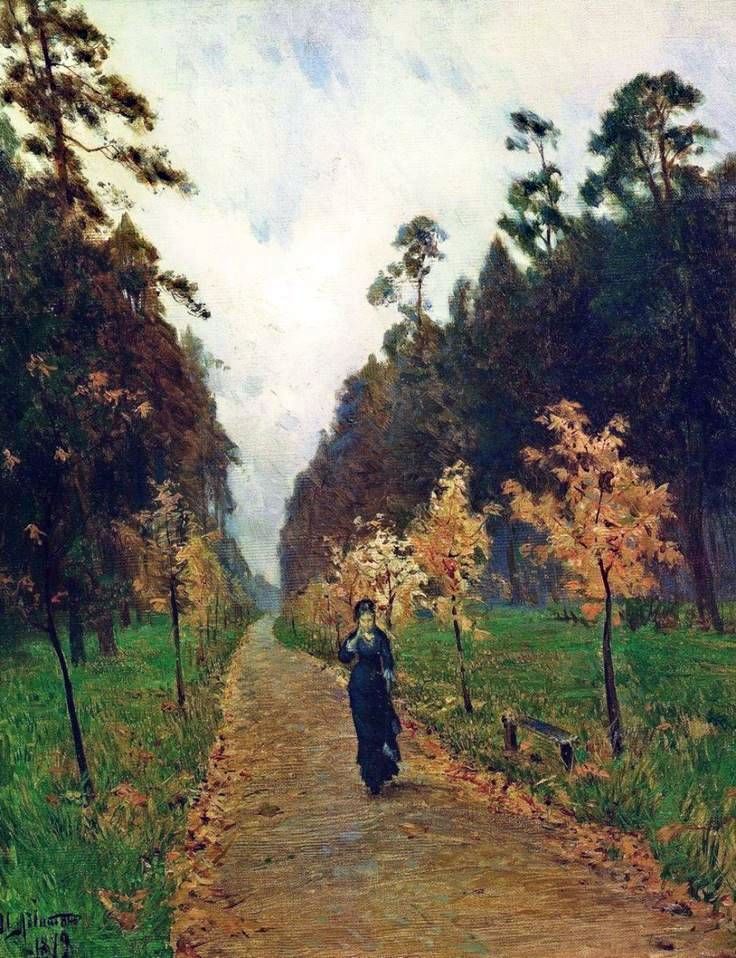
The painting of Isaac Ilyich Levitan “Autumn Day in Sokolniki” of 1879 is one of a kind and happy for the artist!
The fact is that in this picture the first and last time in the artistic life of Levitan at work was a man. Isaac Ilyich himself did not write the lonely frail figure of a woman. His friend, the brother of the writer Anton Pavlovich Chekhov, Nikolai Pavlovich Chekhov helped him in this.
The history of this very picture is wonderfully described in the essay of Konstantin Paustovsky “Isaac Levitan”.
Levitan did not graduate from the School of Painting, Sculpture and Architecture. He had no diploma, no money. Moreover, by imperial decree, Jews were forbidden to live in the capital, and he was evicted to Saltykovka located near Moscow. There, for the first time, Isaac Ilyich, who was eighteen years old at the time, began to write in the air, learning by the advice of Alexei Kondratievich Savrasov, to convey “air” in the film.
Since the artist had no income, he was extremely poor and did not consider it possible to communicate with the circle of summer residents who was at that moment in the village.
The whole summer was spent by a young man in the reeds, on a boat with a sketchbook, trying to convey the summer state of the rural landscape.
Laughter, running children and a young voice singing romances excited the young man. One day he saw his neighbor at the end of the summer with a brisk pace walking past his abode. In her hands she had a small umbrella, and the sleeves of her elegant dress were trimmed with black lace, emphasizing the whiteness of her hands. Tosca, inspired by the words of the romance, the beauty of the Moscow region served as an excuse for the artist to write the autumn landscape. The high, cloudy, bright sky is almost closed at the horizon with a path strewn with fallen leaves. The forest, still dark and the grass is still green, but young maples, planted along the bark, already shine with the autumn flame of a yellow, orange and red leaf.
Memories of the mysterious neighbor made Levitan turn to his fellow practitioner Nikolai Chekhov, who inscribed a sad silhouette in the landscape.
The fragile female figure seems so lonely, so small in this endless airspace framed by a mysterious dark wall of the forest. The woman is dressed in black, as if she wears mourning for the summer.
This picture was the first of Levitan Tretyakov bought for his collection.
Throughout his life, Isaac Ilyich Levitan was under the close attention of Tretyakov, who often bought works from him.
Creativity Levitan marked by the special ability to “talk” with nature and show the beauty and charm of a completely simple inconspicuous corners of his country.
 Jour d’automne à Sokolniki – Isaac Levitan
Jour d’automne à Sokolniki – Isaac Levitan Día de otoño en Sokolniki – Isaac Levitan
Día de otoño en Sokolniki – Isaac Levitan Autumn. Mill. Ples by Isaac Levitan
Autumn. Mill. Ples by Isaac Levitan Autumn. Hunter by Isaac Levitan
Autumn. Hunter by Isaac Levitan Ferns in the forest by Isaac Levitan
Ferns in the forest by Isaac Levitan In the forest in autumn by Isaac Levitan
In the forest in autumn by Isaac Levitan Golden Autumn by Isaac Levitan
Golden Autumn by Isaac Levitan October (Autumn) by Isaac Levitan
October (Autumn) by Isaac Levitan